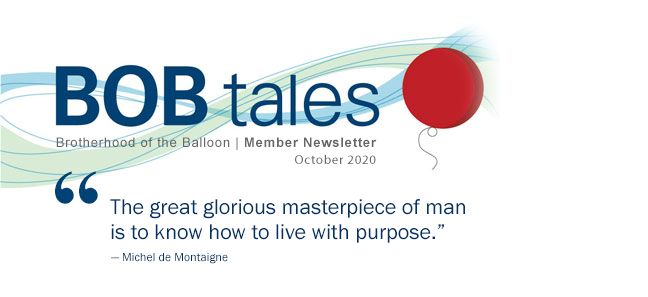
Dear Members (a note from Bob Marckini):
Deb and I often discuss how we think we’re doing on achieving our objectives based on our mission which is:
- To provide aftercare support, communications, and education to our members;
- To help others discover proton therapy;
- To give back to the institution that saved our lives and preserved the quality of our lives.
In general, we think we’re doing reasonably well in all three areas. Our BOB Tales newsletter, as well as hundreds of emails and phone communications annually with members, support our first mission objective.
Regarding objective No. 2, helping others discover proton therapy – our website, Facebook page, and my book reach thousands of newly diagnosed men and their loved ones every year, many of whom choose proton therapy. We know this because of the feedback we receive just about every day. Also, many of our well-educated, passionate members have become ambassadors for proton therapy; they talk about their experience with proton therapy to friends and acquaintances; they forward our newsletters; and they use our PowerPoint presentation to educate groups of people. Some of them hand out copies of my book or place them in doctor’s offices and libraries.
One newly diagnosed patient told us a few years ago, “I chose proton therapy because it was the only treatment option with a fan club.”
On objective No. 3, I’m proud to report that over the years, our members have made contributions of more than $12 million to Loma Linda University Health in several categories. One of these is the endowed proton therapy research chair in my name, which is funded at more than $3 million. Each month, Deb and I communicate with members who’ve made gifts to proton research and other proton-related causes to let them know how much we appreciate their generosity. We also take the opportunity to check in with them and see how they’re doing. You’ll read about one recent conversation in this month’s BOB Tales.
We’re always looking for ways to do more in all three areas, and we welcome suggestions from members on how we can do better.
This month we cover some important and timely topics. We’ve written before about how subjective the needle biopsy interpretation can be. Breakthroughs in artificial intelligence are showing major improvements in biopsy evaluations. Several new developments in prostate cancer screening could soon eliminate the need for invasive and risky needle biopsies. A highly effective test for identifying the locations of metastatic lesions in recurrent prostate cancer patients may someday play a key role in diagnosing primary cancer. And, a new type of biopsy and new prostate cancer screening technology has the potential of eliminating the trauma and risks of the conventional needle biopsy.
Speaking of biopsies, our “Flashback” article this month provides one more reason why a major improvement in prostate cancer biopsy technology is long overdue.
Finally, the proton therapy movement lost a dear friend last month. He’s a former patient who put himself out there in so many ways to promote the benefits of protons. I’m sure you’ll recognize the photo of this wonderful man and enjoy reading his story.
In future BOB Tales newsletters, we plan to focus more attention on preventing cancers and cancer recurrences. Recent research on this subject has produced remarkable findings which we’re eager to share with our membership. Books like The China Study, by T. Colin Campbell, Anticancer Way of Life, by David Servan-Schreiber, MD PhD, How Not to Die, by Michael Greger, MD, and Anticancer Living, by Lorenzo Cohen, MD and Alison Jefferies, MEd are great sources of information on these subjects. We’ll be referencing them along with other articles and studies from prominent researchers and medical professionals.
Many of our members constantly search for new and valuable information on these topics. We routinely receive emails from them, along with links to important articles and studies. Frankly, it’s hard to keep up with them. We’re always backlogged, and it’s difficult to pick and choose which article/study to read next. The world is bursting with new research and publications. Our goal is to sift through them, identify the most valuable information, and abstract that information for our members’ benefit. Links to the original research or articles are always provided.
We hope you enjoy this issue of BOB Tales and as always, we welcome and encourage your feedback. Please send an email to [email protected].
Bob Marckini
To print the BOB Tales newsletter or view the newsletter with a larger font size, click here for the PDF file.
In This Issue:
- Newly Developed AI Capable of Identifying Prostate Cancer With ‘Near-Perfect Accuracy’
- A Blood Test for Prostate Cancer? ‘Liquid Biopsy’
- Two More Prostate Screening Options Showing Much Promise
- PSMA PET/CT Test for Primary Prostate Cancer
- Largest-ever Survey of How Prostate Cancer Patients Feel After Treatment
- Here’s One More Reason to Avoid Surgery
- Chuck Sampson: In Memoriam
- Exercise and Prostate Cancer



Newly Developed AI Capable of Identifying Prostate Cancer With ‘Near-Perfect Accuracy’
 Researchers at the University of Pittsburgh have developed a new artificial intelligence (AI) program that is extremely effective at recognizing prostate cancer.
Researchers at the University of Pittsburgh have developed a new artificial intelligence (AI) program that is extremely effective at recognizing prostate cancer.
Lead author of the study, Dr. Rajiv Dhir, chief pathologist and vice chairman of pathology at UPMC Shadyside and professor of biomedical informatics at UPitt, said, “Humans are good at recognizing anomalies, but they have their own biases or past experience. Machines are detached from the whole story.” In other words, machines – properly programmed – can be more objective in providing analysis and drawing conclusions from visual data where humans can make mistakes.
In chapter 18 of the new edition of You Can Beat Prostate Cancer, Bob Marckini covers this subject in detail under the heading: “The Ten Steps for Taking Control of the Detection and Treatment of Your Prostate Cancer.” Step No. 5 on page 254 is: “Get a Second Opinion on Your Biopsy Results.” Bob explains how critically important it is to have your biopsy slides properly interpreted by a pathologist, since your Gleason score is probably the most important factor in staging your cancer. It provides guidance on answering such questions as: Do you need treatment at all? Or, if treatment is called for, how aggressive should the treatment be? Or, is adjuvant hormonal therapy needed?
To more accurately answer those questions, Bob suggests in his book that all patients ask for a second opinion on their biopsy slides – even if they’re told no cancer is present. Why? Because the reading of pathology slides is subjective, and quite often two pathologists can come to different conclusions when reading the same set of slides.
The book, How Doctors Think by Jerome Groopman, MD, explains the variation in test interpretation by pathologists, radiologists, and doctors representing many other specialties.
On page 255 of Bob’s book, he writes, “Using radiology as an example, Dr. Groopman notes that in one study at Michigan State University radiologists disagreed among themselves 20 percent of the time! And the same radiologists contradict their earlier analyses 5 to 10 percent of the time. In another study involving screening mammograms of 148 women, ‘the fraction of patients actually having cancer who were correctly diagnosed varied from 59 to 100 percent. Overall, the accuracy rate varied from 73 to 97 percent.’”
The bottom line is that the visual interpretation of test results can be quite subjective, and AI has the potential to take the guesswork out of the interpretation of these tests, according to the UPITT study conclusions.
The UPITT team “fed” their program images from over a million parts of tissue slides extracted from prostate cancer patient biopsies. The program was then tested on 1,600 slide images collected from 100 suspected prostate cancer patients.
“The AI performed incredibly well on that test,” according to researchers. “Results show 98 percent sensitivity and 97 percent specificity at finding and identifying prostate cancer. Those stats are much higher than scores recorded by previous cancer-detecting algorithms.”
This algorithm goes far beyond detecting cancer. It also scores extremely well in tumor grading, sizing and assessment of surrounding nerve invasion by cancer.
AI isn’t ready to replace human doctors just yet. Further studies are planned to fully develop the test for prostate cancer detection and staging as well as detection and staging of many other cancers.
A Blood Test for Prostate Cancer? “Liquid Biopsy”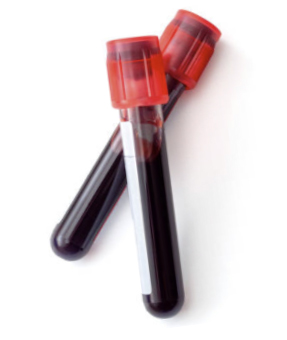
There continues to be much controversy in the detection of prostate cancer. Critics say the PSA test should be eliminated as it results in too much over diagnosis and treatment. New imaging is making targeted biopsies more meaningful. But researchers feel we are far from the optimal test for detecting prostate cancer.
The John van Geest Cancer Research Center at Nottingham Trent University in England has embarked on a program to determine if prostate cancer can be reliably detected using a simple blood test.
The approach they use focuses on the immune system.
The immune system recognizes cancer, so if a test can be developed that can detect changes in the biology/appearance of white blood (immune) cells, they may have their answer.
The test is in the experimental stage. It works by analyzing the biology of immune cells known as natural killer (NK) cells in the blood. These cells are likely to be influenced by the presence of cancer and are the first line of attack against the cancer. Analysis of the data provided by the blood test can predict the presence of cancer and also its severity.
According to an article in News: Medical Life Sciences, “The novelty of this approach is that it interrogates the immunological response to the tumor, not the tumor itself and that it requires a simple blood test (liquid biopsy).” Researchers believe that 70 percent of biopsies could be avoided, sparing men with benign or low-risk disease from unnecessary, invasive procedures that often come with significant side effects.
Another benefit of this test is that it has the potential to find high-risk cancer at an early stage in men with no typical symptoms.
Much more funding and research are needed to bring this research to clinical trial, which is expected in three to four years.
Two More Prostate Screening Options Showing Much Promise
Two additional noninvasive tests that could reduce or eliminate the need for risky biopsies are showing promise. One is a urine test that measures spermine levels and the other is a blood test that looks at free and total PSA along with the -2 pro-PSA isoform (p2PSA).
Urine Test
Spermine levels in urine are inversely associated with both prostate cancer and high-grade prostate cancer, according to Peter Ka-Fung Chiu, MD, from the University of Hong Kong.
Researchers studied 556 men and looked at age, prostate volume, PSA level, and spermine level. Early results showed high predictability of the absence or presence of prostate cancer as well as the probability of high-grade cancer.
PHI Blood Test
We’ve discussed the value of multiparametric MRI (mp-MRI) in detecting prostate cancer in previous BOB Tales. The PHI prostate cancer biomarker has been found to be as predictive as mp-MRI in detecting prostate cancer.
The Prostate Health Index (PHI) test could possibly be used instead of the traditional PSA test. It’s derived from the PSA test, but combines total PSA, free PSA, and the isoform (p2PSA) test.
Using this new test, the number of risky biopsies could be reduced by 40 percent, according to researchers.
PSMA PET/CT Test for Primary Prostate Cancer
 We’ve reported in previous BOB Tales that the relatively new PSMA PET/CT scan provides extremely valuable information when dealing with recurrent prostate cancer. It helps identify cancerous lesions in the body with greater precision and accuracy than other imaging tests. These lesions, in turn, can be destroyed with targeted therapies, such as proton beam, HIFU, focal laser ablation, cryotherapy, and others. The bad news is – to our knowledge – this test isn’t being reimbursed by medical insurers yet, so the patient typically has to pay out of pocket. We expect this to change in the future as more and more test results are suggesting this test is superior to other PET/CT scans, such as Axumin, C-11 Choline, and C-11 Acetate.
We’ve reported in previous BOB Tales that the relatively new PSMA PET/CT scan provides extremely valuable information when dealing with recurrent prostate cancer. It helps identify cancerous lesions in the body with greater precision and accuracy than other imaging tests. These lesions, in turn, can be destroyed with targeted therapies, such as proton beam, HIFU, focal laser ablation, cryotherapy, and others. The bad news is – to our knowledge – this test isn’t being reimbursed by medical insurers yet, so the patient typically has to pay out of pocket. We expect this to change in the future as more and more test results are suggesting this test is superior to other PET/CT scans, such as Axumin, C-11 Choline, and C-11 Acetate.
A recent study suggests this test may also be quite valuable in staging primary prostate cancer.
A single center, retrospective study was conducted at the Department of Nuclear Medicine, The Netherlands Cancer Institute in Amsterdam. Researchers looked at 64 men with intermediate- and high-risk prostate cancer who’d been staged with conventional protocols, including bone scans. They were additionally evaluated with Ga68 PSMA PET/CT.
The findings showed that 23 percent of the men were upstaged and 9 percent were downstaged for locoregional nodal disease; while 13 percent were upstaged and 23 percent downstaged for metastatic disease. Also, a net increase in level of confidence of 20 percent was noted in metastatic cancer status and treatment category was changed from palliative to curative in 9 percent and from curative to palliative in 3 percent. Finally, an undecided treatment plan changed to curative in 14 percent and to palliative in another 9 percent. In total, 36 percent of the treatment categories was changed as a result of PSMA PET/CT evaluation. This is significant.
Researchers concluded, “Findings of this study support the replacement of BS (bone scan) and CT (conventional cat scan) by PSMA PET/CT in staging primary PCa (prostate cancer).”
Largest-ever Survey of How Prostate Cancer Patients Feel After Treatment
 Findings from the first international prostate cancer quality of life study reveal a significant number of men are struggling with debilitating side effects following treatment. The Europa Uomo Patient Reported Outcomes Study (EUPROMS) included 2,943 European prostate cancer patients with an average age of 70. All responded to a comprehensive, online questionnaire within six years after treatment.
Findings from the first international prostate cancer quality of life study reveal a significant number of men are struggling with debilitating side effects following treatment. The Europa Uomo Patient Reported Outcomes Study (EUPROMS) included 2,943 European prostate cancer patients with an average age of 70. All responded to a comprehensive, online questionnaire within six years after treatment.
Note: Proton therapy was not mentioned as a treatment option.
Results suggest that any treatment, with the exception of active surveillance, may negatively affect quality of life. And for many men, side effects may be greater than previously thought.
Results also show different treatments have different effects on quality of life. Radical prostatectomy (surgical removal of the prostate) has the largest reported impact on urinary incontinence. Radiotherapy apparently doubles the fatigue a patient experiences in comparison to surgery, whereas chemotherapy triples the fatigue score. Though both surgery and radiothearpy are reported to have a severe impact on sexual function, the impact of radiotherapy on sexual function is worse than radical prostatectomy.
“We often hear that decline in sexual functioning is a relatively small problem for prostate cancer patients and the effect on their quality of life should not be exaggerated,” said Europa Uomo Chairman, André Deschamps. “We also hear that prostate cancer is typically a disease of ‘old men,’ implying that the loss of sexual function is less relevant. This survey paints a different picture.”
Results suggest that the best quality of life is experienced when prostate cancer is discovered early. “This means efforts toward early detection and awareness are essential to avoid unnecessary deterioration in quality of life …,” said Europa Uomo Chairman André Deschamps.
BOB Comment: If proton therapy had been included in the treatment options studied, we believe the results would have shown fewer side effects compared with surgery, conventional radiotherapy, and chemotherapy. In fact, this study presents yet another reason for men to consider proton therapy for their prostate cancer to improve their chances of avoiding life-altering side effects associated with other treatment modalities.



We’ve been producing BOB Tales newsletters monthly for 20 years. During this time there have been articles that many new members haven’t seen, and some older members may have forgotten. So, we periodically re-run articles from past newsletters. This one from Feb. 2006 is titled:
Here’s One More Reason to Avoid Surgery
One of our members told us last month that he was originally told by his doctor his biopsy was negative. That was the good news. Unfortunately, his biopsy slides had been mixed up with someone else’s. A few months later, this member was notified by his doctor that his slides had been swapped in error with another patient’s. He had a DNA test to confirm this and was then given the bad news that he did, in fact, have prostate cancer.
It gets worse. The other fellow (who received an incorrect diagnosis) acted quickly. He took his urologist’s advice and had a radical prostatectomy. That’s right – he underwent unnecessary surgery to have his non-cancerous prostate removed. Fortunately, the several-month delay gave our member a chance to learn about the alternatives to surgery. Proton therapy was his choice and he’s doing fine.
When we’re asked by prospective patients why we think proton therapy is superior to surgery, our reply is: Proton therapy can cure cancer as well as surgery or any other treatment. Add to that, it’s non-invasive; it doesn’t involve the risks associated with anesthesia; it doesn’t involve the risk of infection, blood loss or trauma associated with surgery; and you can expect fewer side effects. To us it’s a “no-brainer.” Add to that, the small possibility of your pathology slides being mixed up and the decision is easy in our opinion.
BOB Comment: It’s common for hospitals to do a complete pathological analysis of a prostate after it’s been surgically removed. And we’ve heard of other cases of patients learning – after radical prostatectomy – there was no cancer found in their surgically-removed prostate. Even more reason, in our opinion, to ensure you’re having the latest, state-of-the-art (mp-MRI guided) biopsy, along with requesting a second opinion on which to base your treatment decision.



Chuck Sampson: In Memoriam
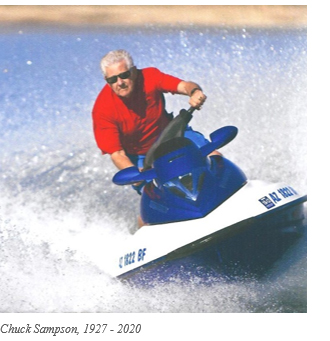 If you’ve been a member for more than 10 years or long enough to recall our old website’s home page; or you’ve requested a copy of our PowerPoint presentation or perused our “Life After Proton” stories, you may recall seeing a photo of an 85-year-old man speeding across a lake on a jet ski. That was Chuck Sampson. Chuck, also a bicyclist, roller blader, waterskier, among other things, was a huge proton therapy advocate and a good friend of ours. We were very saddened to hear from his daughter last month that he’d passed away (not from prostate cancer) at the age of 94.
If you’ve been a member for more than 10 years or long enough to recall our old website’s home page; or you’ve requested a copy of our PowerPoint presentation or perused our “Life After Proton” stories, you may recall seeing a photo of an 85-year-old man speeding across a lake on a jet ski. That was Chuck Sampson. Chuck, also a bicyclist, roller blader, waterskier, among other things, was a huge proton therapy advocate and a good friend of ours. We were very saddened to hear from his daughter last month that he’d passed away (not from prostate cancer) at the age of 94.
Chuck was diagnosed with prostate cancer at age 78 and went to Loma Linda University Cancer Center in 2005 for proton therapy. He had a wonderful experience and became a BOB member and a strong supporter of “the cause.” He’d do just about anything to help us, Deb learned early on. “My goal is your goal,” he said more than once.
Chuck told us he handed out Bob Marckini’s book to “anyone who showed the slightest interest in prostate cancer treatment.” He was also more than willing to share his personal story with others, including new and prospective BOB members. A few times, Chuck shipped us boxes of CDs containing hand-written messages and photos of himself doing all sorts of sports and activites. Included in one of the shipments was a pile of photos of Chuck on his “Sea Doo” ripping across a lake like a professional watercraft racer. The photo to the left was our favorite. “Use it everywhere,” he said. And we did.
We soon learned there was much more to Chuck than his willingness to help others find their way to proton therapy. Chuck was a devout man of God. From his time serving in the Navy and Navy Air Force to his days singing alongside his wife, Hope, an accomplished pianist composer, and other family members at churches and missions conferences all over the midwest, devoting his time to helping others in his church community was important to Chuck. He often led worship at his parish and served at a local center that helped families in need with food, clothing, and other supplies. When the center held two marathon fundraisers every year, Chuck took part in as many of them as he could. “I’ll continue as long as I can,” he told Deb in 2010. And he did.
 Chuck served on numerous nonprofit organizations and church boards. He and Hope also worked with Wycliffe Bible Translators (WBT) to develop a recruiting and training program that was used in all WBT regional offices nationally. Chuck also had relationships with Christian TV stations, developing a program to raise awareness and recruit for WBT worldwide.
Chuck served on numerous nonprofit organizations and church boards. He and Hope also worked with Wycliffe Bible Translators (WBT) to develop a recruiting and training program that was used in all WBT regional offices nationally. Chuck also had relationships with Christian TV stations, developing a program to raise awareness and recruit for WBT worldwide.
Chuck was a special person. And he let others know when he thought they were special, too.
Chuck wrote to Deb in 2016:
God has used you and your father in a remarkable way to help those in desperate need of prostate cancer healing. You’ve gone way beyond what would ever be expected to bring the healing message of proton therapy to those who need it and don’t have a clue. Most people who retire early have no plan for their future. God had a purpose for Bob and you stuck with your calling with heart and soul. At least that’s the way I see it.
May Chuck rest in peace knowing he left his mark on this world. We will remember fondly his selfless and helpful attitude and his great enthusiasm for life.



You Can Beat Prostate Cancer: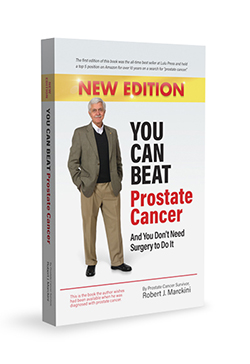
And You Don’t Need Surgery to Do It – Second Edition
As of this writing, the new edition of Bob’s book is again in the No. 1 position on a search for “prostate cancer” on Amazon. All 29 reviews are 5-star and readers have told us via emails and phone calls that the book has changed their lives, and certainly has influenced their treatment decisions.
Some proton centers are sending the book to prospective patients who inquire about proton therapy. We’ve heard from several that the book enlightened them in many ways and influenced their treatment decision. Nothing makes us happier.
Physicians from several prominent medical centers have endorsed Bob’s book. These can be found at the beginning of the book. Following are comments by Sameer Keole, MD, Medical Director, Proton Therapy, Mayo Clinic, Phoenix, AZ.
You’ve just been told you have prostate cancer – the “C” word. Don’t panic. Most likely, there are multiple options that can lead to a great result and that’s what makes prostate cancer treatment decision-making so challenging. Bob Marckini again does a great job of walking patients through this complex process in the second edition of his book, which has been significantly updated. Not all the available options for prostate cancer management are discussed with men by their doctors. Mr. Marckini does a fantastic job of exposing the reader to such options. If you’ve been diagnosed with prostate cancer, or know someone who has, you owe it to yourself, or them, to read this book.
If you’ve read Bob’s new book and have found it valuable, we encourage you to write a review on Amazon. This helps others learn critically important information about prostate cancer prevention, detection, treatment alternatives and proton therapy.
Reminders
The second edition of You Can Beat Prostate Cancer includes a complete update on prostate cancer prevention, imaging technology, diagnostic technology, treatment options, and virtually all aspects of the latest developments in proton therapy.
We’re happy to discount books in quantity (minimum 20) to anyone interested in spreading the word on proton therapy. Just send an email to [email protected]. Proceeds from book sales are used to help fund our efforts and to support proton therapy research.
Please note: The Kindle version is free to Kindle Unlimited members or can be purchased for only $9.99, for non-members. The soft-cover price is $22.45

Buy You Can Beat Prostate Cancer second edition on Amazon or Lulu Press.




Exercise and Prostate Cancer
The benefits of exercise can’t be overstated. Exercise delivers oxygen and nutrients to tissues and helps the cardiovascular system work more efficiently. Exercise has also been shown to improve mood and decrease feelings of depression, anxiety, and stress. Add to that its benefits in improving strength, preventing aging, helping with weight loss and management, reducing blood pressure and cholesterol, improving coordination, decreasing the risk of developing diabetes, and increasing life expectancy. Following, we cover two additional studies and an article on the benefits of exercise for prostate cancer patients.
The Benefits of Acute Exercise on the Immune System of Prostate Cancer Survivors
 New research in Experimental Physiology found that in prostate cancer survivors, a moderate bout of cycling kept the cell count of certain types of immune cells at a normal level. These natural killer (NK) cells are part of the body’s first line of defense. Twenty-four hours after cycling, the NK cell count had returned to resting levels. This suggests the exercise is safe for prostate cancer survivors.
New research in Experimental Physiology found that in prostate cancer survivors, a moderate bout of cycling kept the cell count of certain types of immune cells at a normal level. These natural killer (NK) cells are part of the body’s first line of defense. Twenty-four hours after cycling, the NK cell count had returned to resting levels. This suggests the exercise is safe for prostate cancer survivors.
Although studies have shown that general physical activity helps to reduce the side effects of prostate cancer treatment, the effects of prostate cancer treatment and acute exercise on the immune system have been only briefly examined.
Exercise helps NK cells move into the blood and reach areas of need, such as infection sites and tumors. At the tissues, the NK cells move out of circulation and in cancer patients, infiltrate the tumor and potentially slow its growth rate.
Study: The Effects of Exercise on the Quality of Life of Prostate Cancer Survivors
Another study aimed to investigate the effects of exercise on the quality of life of prostate cancer survivors. Eighty prostate cancer survivors were randomly assigned to intervention and control groups (40 in each group). The intervention group participated in a 12-week exercise program. Data were collected using questionnaires and follow-up checklists.
In the intervention group, statistically significant improvements in physical, emotional, social, and sexual functions were reported. Men in this group also reported reduced fatigue, insomnia, constipation, diarrhoea, urinary, bowel and hormonal treatment-related symptoms.
Exercise Video Series for Men with Prostate Cancer
The Institute for Prostate Cancer Research (IPCR) recently launched a series of exercise videos for men with prostate cancer. The videos provide structured routines, including modifications based on level and interest, that aim to help patients combat the effects of treatment.
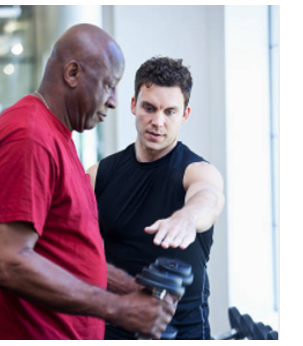 The idea for the series came about in 2019 at an annual IPCR patient symposium. During a breakout session on the importance of physical activity, attendees were encouraged to participate in several simple exercises. Afterward, they filled out a questionnaire. Most of the responses indicated a need for improved information about exercise and how it relates to prostate cancer. To address attendee feedback, a team at Fred Hutchinson Cancer Research Center, along with colleagues at Pfizer, began working on the videos.
The idea for the series came about in 2019 at an annual IPCR patient symposium. During a breakout session on the importance of physical activity, attendees were encouraged to participate in several simple exercises. Afterward, they filled out a questionnaire. Most of the responses indicated a need for improved information about exercise and how it relates to prostate cancer. To address attendee feedback, a team at Fred Hutchinson Cancer Research Center, along with colleagues at Pfizer, began working on the videos.
The project organizers hope the series will allow men with prostate cancer to create routines that suit their specific abilities and provide a resource for improving their overall quality of life.



Active Surveillance & Beyond: Free Webinars
The Answer Cancer Foundation and Us Too International are hosting a series of webinars called Active Surveillance & Beyond. The series of educational presentations, which includes four webinars, is aimed at men on or considering active surveillance (AS) for low- and intermediate-risk prostate cancer and will provide decision-making information and personal interactions.
Dr. Peter Carroll, one of the pioneers of the AS approach, kicked off the series on July 30. Register here to watch a recording of his presentation, “The Past, Present, and Future of Active Surveillance,” and to sign up for three more webinars in this series, which are detailed below.
Sept 29 – Dr. Brian Helfand, Division Chief of Urology, NorthShore University HealthSystem, Glenview, IL, will talk about genomic and genetic testing for AS decision-making.
November 30 – Dr. Antonio Westphalen, Chief of Abdominal Imaging Section, University of Washington, will speak about the value of mpMRI in monitoring men on AS.
December 30 – Dr. Jonathan Epstein, Chairman of Urological Pathology, The Johns Hopkins Medical Institutions, will speak about critical issues of grading prostate cancer for patients considering AS.
Contact [email protected] for information.



They’re Still Giving
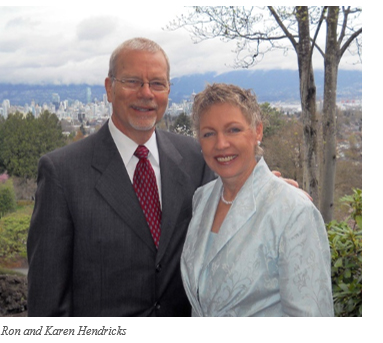 If you’re paying close attention, you see the name Ron Hendricks in most of our newsletters. He is Director of Gift Planning for Trinity Western University and a devoted BOB member. He regularly copies us on his “News from Ron” mailings, which include helpful hints to the readers of his newsletters. Since we’ve found Ron’s suggestions to be timely and beneficial, we often share them in our newsletters with his permission. We started in 2015 in our “Odds and Ends” section with “Estate Planning Hints.” We’ll continue to do so in future issues, but this month, we wanted to place Ron in a different sort of spotlight.
If you’re paying close attention, you see the name Ron Hendricks in most of our newsletters. He is Director of Gift Planning for Trinity Western University and a devoted BOB member. He regularly copies us on his “News from Ron” mailings, which include helpful hints to the readers of his newsletters. Since we’ve found Ron’s suggestions to be timely and beneficial, we often share them in our newsletters with his permission. We started in 2015 in our “Odds and Ends” section with “Estate Planning Hints.” We’ll continue to do so in future issues, but this month, we wanted to place Ron in a different sort of spotlight.
Ron and his wife, Karen, have been “giving back” to Loma Linda University Cancer Center’s proton research program via the Robert J. Marckini Endowed Chair, for many years. For the past few years, they’ve been contributing monthly. They’ve also remembered Loma Linda University Health in their estate plan.
The couple traveled more than 1,200 miles from their home in the northwestern corner of Washington State to LLUCC when Ron was diagnosed with prostate cancer in 2011. They weren’t sure what to expect but loved what they found once they arrived. “Proton treatment changed my life,” Ron said. “I’d never seen such compassion and care.”
When we asked Ron and Karen why they make monthly gifts and why they decided to remember LLUCC in their estate plan, they had a lot to share.
We give because we can – everyone can! The size of the gift isn’t as important as the commitment to give.
We like to have a rhythm to our lives, which is why we’ve chosen to give monthly rather than once per year. We receive our income monthly, so that’s the way we give to Loma Linda. Our largest gift to LLUH will come the second one of us dies. We’ve chosen to give a significant gift through our estate. Our plan is to give our entire retirement fund (IRAs) to charity because that’s the most highly taxable asset we have. All of that tax goes away when given to charities. For us, this is a much better choice than having our children pay this tax.
We’re so thankful that others gave before us so that we could benefit from their generosity. And to ensure the benefit we experienced will be expanded for research to new levels of care, we’ll continue to give as long as we can.
─ Ron Hendricks
My perspective on giving back to Loma Linda is less technical. It’s been nine years since Ron went through his 45 treatments. We arrived with lots of questions and were immediately set at ease. We were called by name and welcomed by fellow patients!
As the days unfolded, the Loma Linda mantra became clear: “We’ll kill the cancer – your job is to heal – emotionally, spiritually and physically.” We made friends; we exercised at the Drayson Fitness Center; we attended church activities and Wednesday night lectures; we took part in restaurant tours and potlucks, etc … It was the most fun we’ve ever had (well, maybe not quite) and it was cancer treatment!
Loma Linda’s commitment to serve us was the best we’ve ever experienced – and we had been in customer service for 40 years! It was just the best; I’d go back in a minute!
─ Karen Hendricks
The Marckini Chair
What’s a “Chair?” Chair is the term used to describe an endowment that provides a steady stream of income to fund the work of research scientists. LLUCC doesn’t receive sufficient revenue from patient care to fund research. Life-saving research is dependent upon the generosity of individuals. With funded chairs, the organization is able to attract and retain some of the best researchers. In addition, scientists are able to dedicate all of their time to research. Without endowment earnings, they could spend a third of their time trying to raise money through grants. A minimum of $2.5 million is needed to fund a chair to support one researcher.
In 2013, Bob Marckini was honored by the board of directors at Loma Linda University Health. Through a generous gift from BOB member and good friend of Bob’s, Chuck Kubicki, they established an endowed chair in Bob’s name for his contributions in promoting proton therapy and his support of proton therapy research.
Since then, BOB members have regularly contributed to the chair, often in honor of Bob Marckini, care givers at LLUCC, or family members. Thanks to you – our members – the Marckini Chair is funded at more than $3 million and continues to support important research at LLUCC.
Give to Proton Therapy Research
- Donate to the Marckini Chair online.
- Write a check to LLUCC Proton (Put “Marckini Chair” on the memo line) and mail to LLUH, Office of Philanthropy P.O. Box 2000, Loma Linda, CA 92354.
- Call Regina Joseph at 909-558-5010 to donate over the phone.
- Donate to other areas of need at LLUH.



Stange but True Facts
- The name for the shape of Pringles is called a “hyperbolic paraboloid.”
- There’s a McDonald’s in every continent except Antartica.
- Mr. Potato Head was the first toy to be advertised on TV.
- A duel between three people is called a “truel.”
- The process by which bread toasts is called the “maillard reaction.”
- Snails have 14,000 teeth and some snails can even kill you!
- Even though Froot Loops are different colors, they all have the same flavor.
- The human nose can remember 50,000 scents.
- The television was invented two years after the invention of sliced bread.
- Bullfrogs don’t sleep.
- It took the creator of the Rubik’s Cube, Erno Rubik, one month to solve the cube after he created it; as of June 2018 the world record is 4.22 seconds.
- Tigers have striped skin, not just striped fur. The stripes are like fingerprints and no two tigers have the same pattern.
- Ketchup originated in China as a boiled-down brine of pickled fish and spices called “ke-chiap.”
- If you die in Amsterdam with no next of kin, and no friends or family to prepare funeral or mourn over your body, a poet will write a poem for you and recite it at your funeral.
- The collars on men’s dress shirts used to be detachable. This was to save on laundry costs as the collar was the part that needed cleaning most frequently.



Last Month’s Brain Teaser/Riddle
You see a boat filled with people. It has not sunk, but when you look again you don’t see a single person on the boat. Why?
Answer: All the people on the boat were married.
Winner: Last month’s winner is BOB member, Ivars Ambats of Darien, IL. In his response to us, he wrote:
In 2010, Bob’s book led to my selection of proton therapy and my “proton vacation” at Loma Linda. Thanks, Bob!
New Brain Teaser
You measure my life in hours, and I serve you by expiring. I’m quick when I’m thin and slow when I’m fat. The wind is my enemy. Who or what am I?
Send your answer to [email protected] for a chance to win a signed copy of Bob Marckini’s NEW second edition book, You Can Beat Prostate Cancer.
Children and Grandparents
- I was in the bathroom putting on my makeup under the watchful eyes of my young granddaughter, as we’d done many times before. After I applied my lipstick and started to leave, the little one said, “But Gramma, you forgot to kiss the toilet paper goodbye!” I’ll probably never put lipstick on again without thinking about kissing the toilet paper goodbye.
- My young grandson called the other day to wish me happy birthday. He asked me how old I was, and I told him, 80. My grandson was quiet for a moment, and then he asked, “Did you start at one?”
- After putting her grandchildren to bed, a grandmother changed into old slacks and a droopy blouse. She removed her make-up and proceeded to wash her hair. As she heard the children getting more and more rambunctious, her patience grew thin. Finally, she threw a towel around her head and stormed into their room, putting them back to bed with stern warnings. As she left the room, she heard the 3-year-old say with a trembling voice, “Who was THAT?”
- My grandson was visiting one day when he asked, “Grandma, do you know how you and God are alike?” I mentally polished my halo and I said, “No, how are we alike?” “You’re both real old,” he replied.

Quote of the Month: "To play it safe is not to play." —Robert Altman




Old People “Pride”
In modern terms we’re called, “senior citizens” and usually just discounted as “old people.” But we have “pride,” too!
You can spot us at sporting events; during the playing of the National Anthem we stand up and remove our hats, place our right hand over the heart, stand at attention and sing along without being embarrassed. We know the words and believe in them.
Old people remember World War II, Pearl Harbor, Guadalcanal, Normandy and Hitler. They remember the Atomic age, Korean War, the Cold War, Jet age and the moon landing, “peace keeping” missions and Vietnam.
Should you bump into an old person on the sidewalk, he’ll apologize. If you pass one on the street, he’ll nod or tip his hat to a lady. Old people are courteous to women and treat them with respect.
Old people hold the door open for the next person. Old people get embarrassed if someone curses in the presence of women or children, they don’t like filth or dirty language on TV or in movies.
Old people have moral courage and personal integrity. They seldom brag unless it’s about their children, grandchildren, or their animals.
Old people know who protects our freedom – not politicians but young, brave men and women in the military, serving their country.
Yes, this country needs old people who understand work ethic, sense of responsibility, pride in their country, and decent values.
Thank God for old people! We need them now more than ever.
Bob Marckini and Deb Hickey
To print the BOB Tales newsletter or view the newsletter with a larger font size, click here for the PDF file.
NO MEDICAL ADVICE: Material appearing here represents opinions offered by non-medically-trained laypersons. Comments shown here should NEVER be interpreted as specific medical advice and must be used only as background information when consulting with a qualified medical professional.
